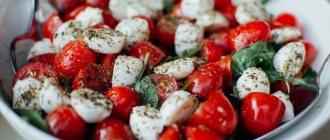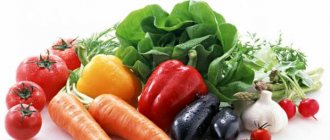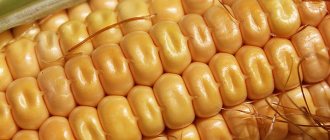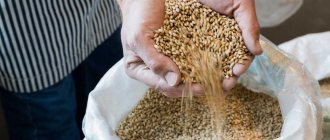Vegetables
Products from this category have a complex positive effect on the body, saturating it with a number of nutritional components necessary for the full development of the body.
Zucchini
One normal-sized fruit contains no more than 7 g of carbohydrates. When preparing side dishes for meat dishes, it is recommended to use these fruits, cut into strings with special devices, as an alternative to spaghetti.
Finely grated zucchini can be used when preparing potato pancakes (replace potatoes with them). The product can also be added to the dough instead of flour.
A nutritious low-carbohydrate snack is prepared from zucchini, recommended for consumption when losing weight, according to the following algorithm:
- The top and bottom edges are cut off from the fruit.
- The zucchini is cut into wide, elongated strips.
- Place arugula or a piece of smoked salmon on one end of the strip, wrap the product like a roll, after which it is ready to eat.
In addition to the low carbohydrate content, zucchini is famous for the presence of the following components:
- magnesium;
- potassium;
- vitamin B6;
- ascorbic acid (vitamin C).
Swiss chard
There are 1 g of carbohydrates per 1 cup of product. The product is suitable for steaming or frying. When preparing rolls or tacos, leaves can be used to replace high-carbohydrate tortillas.
Swiss chard is rich in potassium, which reduces the risk of developing cancer and cardiovascular diseases.
Celery
The stem of the plant contains 1 g of carbohydrates. The low content of these substances in the vegetable is due to the fact that it consists of 95% water. The product is cut into slices and added to the salad or nut butter is spread on it. The result is a nutritious snack with a minimal carbohydrate content.
Celery is a source of vitamin K, which is involved in calcium absorption and strengthening the skeletal system.
Cauliflower
One cup of the plant contains about 5 grams of carbohydrates. When boiled, the vegetable is a worthy alternative to mashed potatoes with a much lower carbohydrate content. The product can also be used instead of the following foods:
- cheese;
- pizza;
- pasta;
- creamy soups.
Cauliflower is used instead of rice or millet porridge. To do this, you need to run a head of cauliflower through a food processor.
Like all members of the Cruciferous family, cauliflower can provide the human body with the necessary amount of antioxidants.
Cherry tomato
Carbohydrate content: 6 g per 1 cup. Cherries differ from ordinary tomatoes in their reduced size and higher taste. It is recommended to consume them either fresh or processed with vegetable oil and baked in the oven at a temperature of about 200C.
The product is a source of lycopene, which has a preventive effect against the development of cancer.
Useful properties of cereals. Why do we need porridge in our diet?
- It is an ideal source of energy
In developed countries, grains make up about 30% of total calories in the diet, while in poor countries it is between 70 and 80%. They are inexpensive and have a relatively low energy density, i.e., in other words, they reduce the feeling of hunger due to the volume they occupy in the stomach. Cereals allow us to consume less of other foods, including unhealthy fats and sugar.
- High content of protein, vitamins and minerals
Protein in cereals makes up 7-14% of the total mass and comes in different types, usually from the gluten group. This protein contains a good set of essential amino acids, with the exception of lysine. Therefore, vegans should combine cereals with legumes, which contain plenty of lysine.
An important beneficial property of cereals is the saturation of the human body with minerals (mainly magnesium, potassium, iron, phosphorus, selenium, calcium) and B vitamins. However, most of the vitamins are contained in the skin of the grains and, accordingly, are lost during processing. Therefore, whole grains and products made from them are more useful than crushed, polished, etc.
Brown and wild rice are much healthier than white rice
- Maintaining blood sugar and insulin levels
Most grains, with the exception of white rice and corn, have a low glycemic index (GI). The concept of GI suggests that the slow rate of carbohydrate digestion may play an important role in the prevention and treatment of chronic diseases. It is believed that after eating with a low GI, the rate of glucose absorption, the growth of hormones in the gastrointestinal tract and insulin decreases. In general, the more fiber a grain contains (which helps reduce the rate at which carbohydrates are digested), the better it helps maintain healthy blood sugar and insulin levels.
Several studies have shown that low GI diets cause greater weight loss than high GI diets. Epidemiological studies have also found an association between high GI diets and chronic diseases, coronary heart disease, type 2 diabetes and cancer. In experiments, wheat and rye cereals with a high fiber content showed a decrease in insulin by 46-49% and glucose by 16-19% in middle-aged overweight men after meals. The authors concluded that even in the short term, whole grains may reduce the glycemic response.
Whole grains and grains may help you live longer
- Cardiovascular Health
Several large cohort studies in America, Finland and Norway have shown that people who eat plenty of whole grains are significantly less likely to have congenital heart defects and strokes. Moreover, a 2003 review of research by Hu found an inverse association between cereal consumption and the risk of cardiovascular disease.
Scientists are considering 2 versions of this effect of whole grains on heart health:
- The effect of soluble fiber on cholesterol levels. A meta-analysis of 67 studies found that soluble fiber (2-10 g/day) helps reduce total cholesterol and “bad” LDL cholesterol in particular.
- The influence of the glycemic index on blood lipids. Studies have shown that a low GI diet helps maintain levels of "good" HDL cholesterol, regardless of fiber intake.
- Improved bowel function
The healthiest grains contain a lot of insoluble fiber, which absorbs liquid (thereby increasing stool weight and helping treat constipation), promotes the growth and activity of intestinal bacteria, and improves many indicators of intestinal health, including. reduction of secondary bile acids, etc.
The World Cancer Research Fund currently lists fiber as a possible risk reducer for colorectal cancer, although studies have not been able to confirm this for sure.
There is also incomplete evidence that whole grains have benefits in reducing the risk of pancreatic, breast, upper gastrointestinal, bladder and kidney cancers. This may be due to the fact that grains contain lignans - plant estrogens that are modified by intestinal bacteria.
Cereals are very beneficial for the gastrointestinal tract and cardiovascular system
- Ability to lower blood pressure
First of all, cereals are low in sodium, which has been linked to hypertension in older people and diabetics. In addition, scientists have discovered that the so-called helps to defeat hypertension. Dietary approach (DASH or Dietary Approaches to Stop Hypertension) - increasing the consumption of a range of foods, including whole grains, but with a special emphasis on fruits, vegetables and low-fat dairy products. The DASH diet was shown to be beneficial in lowering systolic blood pressure by 11.4 mmHg. Art. and diastolic blood pressure by 5.5 mm Hg. Art. in 133 patients with hypertension.
Fruits
The products are high in nutrients and low in carbohydrates.
Apricots
One normal-sized fruit contains about 4 g of carbohydrates. Fruits are consumed both fresh for quick saturation, and added in a crushed state to oatmeal, yoghurt, and salads in order to add sweetness to food.
Apricot pulp contains a significant amount of beta-carotene. This antioxidant has a positive effect on brain functioning.
Strawberry
A cup of fruit contains no more than 11 g of carbohydrates. Of all the berry crops, cranberry contains the least amount of sugar, which significantly increases its health benefits and reduces the level of calories.
Strawberries are among the foods that are sources of ascorbic acid. This component strengthens the immune system and protects the body from colds.
Avocado
The fruit contains about 4 g of carbohydrates. Most of these carbohydrates are in the form of dietary fiber, which cannot be absorbed by the intestines. The product is almost completely sugar free.
Avocado is characterized by the presence in its composition of a significant amount of monounsaturated fatty acids, which have a positive effect on the condition and functioning of the heart.
Red grapefruit
A cup of fruit contains about 18 grams of carbohydrates. The product contains 20% less sugar than oranges. The taste of the fruit is quite sour, so you should not try to overpower it with sugar.
One of the components of grapefruit is ascorbic acid.
Meat and fish
Products from this category are considered the most satisfying and nutritious, which, given the low amount of carbohydrates, opens up broad prospects for use in dietary nutrition.
Som
This fish is completely free of carbohydrates. Relatively cheap products allow you to supply your muscles with pure, high-quality protein. You can steam catfish fillets, bake them on the grill or in the oven, or fry them in a frying pan.
Fish contains vitamin B12, which is necessary for the normal functioning of the nervous system.
Chicken drumstick
100 g contains 0.63 g of carbohydrates. The advantages of this part of the chicken over regular chicken fillet are as follows:
- it is more juicy;
- does not dry out during cooking;
- characterized by rich taste.
However, the skin contains a significant amount of fat, so it is recommended to cut it off when used in dietary foods.
Chicken drumstick can saturate the body with selenium and proteins.
Pork tenderloin
This product contains no carbohydrates. Pork tenderloin is characterized by excellent taste and high juiciness, as well as low cost. The ratio of proteins to fats is 6:1, which makes it an indispensable component of dietary nutrition.
When purchasing prepared tenderloin, you should refrain from purchasing meat with seasonings. This measure will prevent salt and other undesirable ingredients from being included in the menu.
In addition to its high protein content, pork tenderloin is characterized by the presence of thiamine, a B vitamin that promotes accelerated energy production in the body.
Roast beef
Carbohydrate level: 0.36 g per 100 g of product. It is recommended to eat food for breakfast, preparing a low-carb dish according to the following recipe:
- Several pieces of roast beef are wrapped in cabbage or beet leaves.
- Add Dijon mustard, avocado, red pepper or cheese to taste.
Beef roast beef contains a type of iron that is absorbed by the body and can normalize the functioning of the muscular system.
Canned pink salmon
1/2 can has zero carbs. The product is a good source of protein, completely free of carbohydrates. Unlike a number of other fish, pink salmon does not contain mercury or other toxic substances.
Eating this fish allows you to supply the body with omega-3 fatty acids, which intensify protein production in the muscles and reduce pain after exercise.
Ground turkey
The carbohydrate content is 0.48 g per 100 g of meat. This product is an excellent source of healthy proteins in the complete absence of carbohydrates. Minced meat is used in preparing meat dishes or burgers. Using minced meat based on white meat allows you to further reduce the calorie content of the product.
The growth of muscle mass can be intensified due to the action of amino acids contained in minced turkey.
Sirloin steak
The product contains no carbohydrates and is suitable for saturating the body with proteins. The product is widely used in pickling, after which it becomes even more tender and soft. The nutritional value is higher for those steaks that are prepared from plant-fed beef.
Steak is a source of creatine, which promotes energy production.
Moose meat
There are 0 g of carbohydrates per 100 g of product. This type of meat is considered a delicacy, however, recently it is increasingly found on store shelves.
When elk graze on plant-based pastures, their meat accumulates more omega-3 fats than meat from farmed animals fed corn or soy.
Dairy
Among the products in this category there are foods that are good for your figure.
Gruyère cheese
There are no carbohydrates in 100 g of product. A distinctive characteristic of this category of cheese is its pleasant nutty smell. Gruyère has the ability to melt quickly, which allows it to be used in a variety of dishes.
Cheese is a source of calcium, which strengthens bone tissue and is involved in burning fat deposits.
Chicken eggs
One large egg contains about 0.5 g of carbohydrates. Among all products containing large amounts of protein, chicken eggs are considered the highest quality.
The product is a source of antioxidants and is involved in the fight against free radicals that damage the body's cells.
Greek yogurt
1 cup of product contains 9 g of carbohydrates. One serving of yogurt contains 23 g of protein. In order not to introduce excess carbohydrates into the body, you should select a product that contains a small amount of sugar.
Greek yogurt contains a significant amount of prebiotics, which ensure the normal condition and functioning of the immune and digestive systems.
Butter
In 1 tbsp. l. The product does not contain carbohydrates. The product is recommended for use in making mashed potatoes, for which it is mixed with steamed cauliflower, two pinches of salt and thyme.
Unlike various substitutes (such as margarine), butter does not increase the content of bad cholesterol and increase the risk of developing cardiovascular diseases.
Cottage cheese
There are about 6 g of carbohydrates per 1 cup of product. The dish is extremely popular among athletes due to its high protein content (about 14 g/100 g).
Cottage cheese also contains casein, which is slowly absorbed by the body. When consuming the product at night, casein will supply the muscular system with protein.
Goat milk
Carbohydrate content: 11 grams per cup, much less than cow's milk. Goat milk is much better absorbed by the human body. It also contains significant amounts of omega fatty acids and other nutrients.
Burning of fat reserves occurs faster due to the presence of conjugated linoleic acid in food.
The benefits of cereals for the body, taking into account the minerals in their composition
Cereals help saturate our body with minerals such as:
- Calcium Ca (RDI 1100 mg) - needed by the body to maintain healthy bones and teeth; helps muscles move and nerves carry messages between the brain and other parts of the body; used by blood vessels to move blood and is involved in the release of hormones and enzymes that affect almost every function in the body;
- Iron Fe (RDA for men 8 mg, for women 18 mg) - plays an important role in the production of certain hormones and connective tissue, as well as the proteins hemoglobin, which carries oxygen from the lungs to all parts of the body, and myoglobin, which delivers oxygen to the muscles;
- Magnesium Mg (RDA for men 410 mg, for women 315 mg) – important for many processes in the body, including the regulation of muscle and nerve function, blood sugar and blood pressure, protein, bone and DNA production;
- Phosphorus P (RDI 700 mg) – essential for bone health, muscle movement, energy production, waste filtration, and repair of tissues and cells in the body;
- Potassium K (RDA 3,500 to 4,700 mg) – an electrolyte that maintains the balance of fluids in the body and helps transmit electrical impulses to ensure proper functioning of nerves and muscles; regulates calcium and phosphorus levels, and is therefore also necessary for strong and healthy bones;
- Selenium Se (DVD 55 mcg) – important for reproduction, thyroid function, DNA production and protecting the body from damage caused by free radicals and infections;
- Zinc Zn (RDA for men 11 mg, for women 8 mg) - helps the immune system fight bacteria and viruses, is involved in the creation of proteins and DNA, is important for wound healing and the correct perception of taste and smell.
Note that all cereals contain very little sodium, a potentially dangerous mineral, the consumption standards of which are no more than 2300 mg per day for an adult and no more than 1500 mg/day for people over 50 years of age.
The following table shows how many minerals are found in different cereals. From it you will see that the healthiest grains are amaranth, quinoa, oatmeal, teff and wild rice. Also, different varieties of wheat and bulgur can boast a large amount of minerals.
Quinoa contains many minerals and vitamins
Plant proteins
Products from this category allow you to saturate your body in a short time without unnecessary carbohydrates.
Tofu
100 g of product contains only 3 g of carbohydrates. Tofu does not belong to the category of products with high taste qualities, as a result of which it is recommended to make it a component of side dishes from vegetables and other dishes, since tofu quickly absorbs their smell. The product can be used as a source of protein. To do this, you need to fry the tofu in a frying pan or marinate it and place it on the grill.
Tofu is made with isoflavones, which help lower blood pressure.
Pinto beans
There are 36 g of carbohydrates per 100 g of product, which is one of the lowest among legumes. When consuming a serving of the product, you can enrich the body with 12 g of proteins. The dish is used when preparing scrambled eggs or salads.
The product contains a significant amount of dietary fiber, which helps lower blood sugar levels.
Tempe
The carbohydrate content per 100 g of product is 9 g. Tempeh is made from fermented soybeans, which makes it a source of healthy protein. The product is recommended for adding to tacos, sauces, chili and soups.
Tempeh contains prebiotics that have a positive effect on the digestive system.
Pumpkin seeds
6 g of product contains 1 g of carbohydrates. The amount of protein compounds in one serving is 7 g. The seeds are almost completely sugar-free, so they can be added to cereals, cottage cheese, salads or yoghurts to increase the protein content.
Pumpkin seeds can saturate the body with the necessary amount of zinc.
How do you understand the term “low carb”?
It's worth understanding what carbohydrates are and how to avoid them. A “low carb” diet will look different to different people. In most general terms, however, a low-carb diet means that you only get about 20 to 30 percent of your daily calories from carbohydrates—such as added sugars, grains, fruits or starchy vegetables. This is usually around 50-100 grams or less. In some cases, for example, if a person is following an LCHF (low carb, high fat) or ketogenic diet, which is also a low-carb diet, he may consume even fewer carbohydrates, about 20-50 grams per day, in order to enter a state of ketosis (a condition in which fat is burned instead of glucose/carbohydrates to produce energy).
If you set a goal to consume about 100 grams of net carbs per day, divide it between three main meals, with 30-35 grams of net carbs in each. What are net carbs? This is the amount of carbohydrates obtained after subtracting the weight of fiber from the total amount of carbohydrates.
In other words, fiber doesn't count toward your total because it isn't actually digested and doesn't affect your blood sugar like glucose does. For this reason, most people, even on a very low-carb diet, still try to consume fiber-rich foods such as non-starchy vegetables and the occasional nut/seed.
Even those on a very low-carb/ketogenic (with a daily carbohydrate intake of about 20-30 grams or less) diet can still eat any non-starchy vegetables, as they are high in fiber, high in water and nutrients, highly filling and very filling. few calories.
What would a low carb meal look like with 30-35 grams of net carbs?
One meal on a low-carb diet may include the following:
An 85-gram serving of protein (such as chicken breast), 2 cups of non-starchy vegetables such as broccoli and peppers, a salad of assorted greens tossed with 1 to 2 tablespoons of oil or dressing. All of this will contain less than 35 grams of pure carbohydrates. If you replace vegetables with starchy ones, say, beets or turnips, you would get more carbohydrates, but not much. For a meal to be considered moderate or high carbohydrate, you would need to add cereals, fruits, sweeteners like honey or potatoes - and this is 20-25 (or more) grams per serving.
- Lettuce leaves or something green and decorative, such as cabbage, on which vegetables with chopped chicken, sprinkled with sesame seeds, are laid out.
- Fajitas with any protein of your choice and lots of vegetables
- Chicken or salmon burgers
- Empanadas or quesadillas made from almond and coconut flour with farm-raised beef and cheese
- Cabbage-based pizza
- And many other options, like smoothies, casseroles and slow cooker dishes
Snacks
This product allows you to quickly saturate your body and satisfy your hunger without causing harm to your health or causing excess weight gain.
String cheese
The product does not contain carbohydrates. The high taste of this food is well known. It contains a significant amount of milk protein with improved quality, which helps increase muscle mass.
Like other types of cheese, string cheese contains a large amount of calcium.
Walnuts
There is 1 g of carbohydrates per 7.5 g of product. Eating nuts will not only saturate your body with safe, carbohydrate-free food, but also provide it with omega-3 fatty acids. To control your sodium levels, you should only purchase unsalted nuts.
Walnuts promote accelerated energy production in the body. This is due to the increased copper content in the products.
Jerky
100 g of meat contains about 10 g of carbohydrates, while the product is characterized by a high protein content. You should be careful when purchasing the product because beef or turkey meat is often soaked in sweeteners.
Eating dried meat helps eliminate zinc deficiency in the body.
Kale-based chips
100 g of product contains only 30-33 g of carbohydrates. The starch content in chips from the plant is reduced by a third compared to classic potato chips.
These chips contain a significant amount of vitamins A, C, K.
Pros and cons of foods without carbohydrates
Products without carbohydrates, the list of which is quite wide, can bring both pros and cons for the body.
The positive points include:
- decreased appetite and loss of hunger - when consuming carbohydrates, blood glucose levels increase as food is digested. After 2-3 hours, the glucose concentration decreases, and the feeling of hunger begins to increase with renewed vigor. If you refuse to consume carbohydrate products, this mechanism stops working, since more time and energy are spent on digesting protein foods;
- improvement of metabolism - quick sweet snacks undermine the functioning of insulin and can lead to the development of diabetes in the future. When carbohydrates are excluded from the diet, the body gradually rebuilds itself and burns fat reserves, while it no longer needs to obtain glucose from junk food;
- there is no need to count calories - the exclusion of carbohydrate products leads to a decrease in caloric intake by 20-25%. In the absence of carbohydrates, they usually follow a protein diet (keto diet), in which the set of products is composed in such a way that it is difficult to overeat;
- weight loss – carbohydrates and salts retain fluid in body tissues and contribute to the development of swelling. When carbohydrate foods are excluded, the body begins to intensively lose accumulated excess fluid.
If you give up carbohydrates, you may encounter such unpleasant consequences as:
- weight gain - this can happen with heavy consumption of protein foods with excess fat content (avocados, cheeses, nuts);
- gastrointestinal disorders - with a high concentration of protein in the diet, it becomes difficult for the stomach to digest such food, so nausea may develop;
- feeling of fatigue - when consuming carbohydrate products, glycogen contained in carbohydrates easily enters the bloodstream and energy is quickly released. When giving up carbohydrates, the metabolic system needs some time to adjust so that the body learns to produce energy from the fats and proteins consumed.
Also, due to the restructuring, weakness and signs of acute respiratory viral infections may develop, a constant desire to snack on sweets may develop, and slight hair loss may occur. After a short period of time, the body adapts and all symptoms disappear.
Beverages
In order to combat excess weight, not only food, but also drinks are widely used.
Tea without sugar
The product is completely free of carbohydrates and sugar. The drink perfectly quenches thirst.
The most effective is green tea, which contains a high amount of antioxidants. These components, coupled with appropriate training, accelerate the destruction of fat reserves.
Maple sap
There are 3 grams of carbohydrates per cup. The drink tastes like coconut milk, however, the sugar content in the juice is two times lower.
Maple sap is a natural source of magnesium, which is necessary for the full development of the skeletal system.
Almond milk
One serving of the drink contains only 2 g of carbohydrates. The drink is suitable for making protein-based cereals or shakes. Before purchasing, be sure to look for the words “unsweetened milk” on the packaging. This is due to the fact that a number of manufacturers add saccharides to the product.
The drink enriches the body with vitamin E, which is recommended for consumption by people involved in sports. The component is responsible for the restoration of cells that have been damaged as a result of oxidative stress.
Tomato juice
1 cup of drink contains 10 g of carbohydrates. Tomato juice contains half as much sugar as orange juice. The drink should be 100% natural, and not a mixture of juices and sweeteners.
Drinking tomato juice is believed to help combat post-workout inflammation and speed up the recovery process.
Fats and oils
Among this category there are also a number of products that are recommended for consumption on a low-carb diet.
Oil
The product contains no carbohydrates. For a long time, the product was considered unhealthy due to its high fat content, but now the attitude towards it has been revised. The most beneficial is butter obtained from cow's milk.
Extra virgin olive oil
There are no carbohydrates in the product at all. This is one of the healthiest oils. The world famous Mediterranean diet is based on it.
The product contains a number of anti-inflammatory components and antioxidants that have a positive effect on the condition of the cardiovascular system.
Coconut oil
Carbohydrate content: 0 g per 100 g of product. The product contains medium chain fatty acids and healthy fats, which intensify the metabolic process. Consuming oil helps burn fat, reduce appetite, and smooth out fat deposits in the abdominal area.
Fruits and berries
If it is better to avoid dried fruits on a low-carb diet, then you can treat yourself to fresh fruits, showing a sense of proportion and being guided by knowledge of how much carbohydrates a particular fruit contains.
Lemons
It has the lowest indicator and is an excellent help in the fight against colds, due to the content of a large amount of vitamin C. The carbohydrate content of the sunny fruit does not exceed 5 g.
Apricots
Apricot will help increase performance and replenish strength. It is advisable to consume it during the season, because it is in such fruits that the content of vitamins and other nutrients tends to be ideal. Beta-carotene contained in apricots has the magical property of preventing heart disease and even preventing the formation of cancerous tumors. And the amount of carbohydrates is quite low - only 8 g per 2 fruits.
Strawberry
As with apricots, it is better to buy strawberries at the height of the season to get the maximum benefit, rather than chemical components. Red berries contain very little sugar, but their natural sweetness will pacify the ardor of sweet lovers. 11 g. Carbohydrates per 100 g. Strawberries - an excellent indicator!
Apples
Apples are loved all over the world and not only by supporters of a low-carb diet. Enriched with vitamins A and B, pectin, and minerals, these fruits help maintain health and beauty. Skin diseases, brittle nails and hair, atherosclerosis are just some of the problems in which apples relieve symptoms and help fight illness.
Sweets
Among the foods in this category, there is one that contains some sugars, which makes it beneficial for health and figure.
Marshmallow
100 g of product contains about 70 g of carbohydrates. Due to its rich chemical composition and low calorie content, the product is recommended for use in dietary nutrition. You should give preference only to the classic version of the delicacy, which contains exclusively natural ingredients.
Marmalade
There are 76 g of carbohydrates in 100 g of marmalade. Only a fruity type of dessert that is not sprinkled with sugar is good for your figure. The delicacy contains a number of elements that help normalize the digestive process.
Honey
The carbohydrate content per 100 g is 81.5 g. The product is a worthy alternative to sugar when added to tea. Honey is used to sweeten porridges, season walnuts, and prepare dessert dishes with muesli.
Summarize
- While many low-carb diets do not exclude grains, many varieties are suitable for a healthy, controlled carbohydrate diet.
- In fact, many types of grains are high in fiber and low in net carbohydrates, which is the amount of carbohydrates the body actually digests.
- For best results, be sure to choose whole grain varieties and avoid highly processed or refined grains whenever possible.
The article was prepared by experts for informational purposes only. It should not be used as a guide for treating medical conditions and is not a substitute for professional medical advice, diagnosis, or treatment. In case of illness or any symptoms, you should always consult a doctor and not self-medicate.
Tags: carbohydrates
About the author: Alexander Fedorov
Candidate of Biological Sciences, biologist, nutrition expert. Graduated from Stavropol State University with a degree in Biology at the Faculty of Biology and Chemistry.
- Related Posts
- 14 Healthy Whole Grains (Including Gluten-Free)
- Is white rice healthy? Benefits and harm to the body
- Barley and wheat: what's the difference?
« Previous entry
Other products
Other vegetables, fruits, meats, fish and dairy products with minimal and low carbohydrate content include those presented in the table:
| Category | Grocery list |
| Vegetables |
|
| Fruits |
|
| Meat |
|
| Fish |
|
| Dairy |
|
Among plant-based proteins, snacks, drinks, fats and oils, and sweets, low-carb foods include:
| Category | Grocery list |
| Plant proteins |
|
| Snacks |
|
| Beverages |
|
| Fats and oils |
|
| Sweets |
|
Among the extensive list of products with low carbohydrate content, you can always choose suitable dishes for each patient.
Plant products
Tofu
Soy tofu cheese has gained popularity in many countries, which is not surprising. High in protein, calcium and amino acids with low carbohydrate content. It is invaluable not only for vegetarians. The consistency of this cheese, which is essentially more like thick cottage cheese, allows it to absorb the aromas and flavors of dishes served with tofu. It can be cooked separately, pre-marinated in the same way as meat and fried a little. Tofu can protect the body from heart disease and even remove toxins, and the presence of isoflavones will help normalize blood pressure.
Pumpkin seeds
These seeds have an excellent composition, and their beneficial properties are striking in their diversity. Moreover, one serving contains a lot of protein, and only 5 g of carbohydrates. for 30 g of seeds. They will add piquancy to many dishes from salad and cottage cheese to soup and scrambled eggs and will become an additional source of protein. Also, such seeds will enrich the body with zinc, which is essential for metabolism, supporting the name system and normalizing hormonal levels.
Tempe
This protein product comes from Indonesia. It is a fermented soybean compound in the form of nougat. The soy product is rich in protein, sodium and iron, and also provides 24% of the daily value of riboflavin. By the way, you can use it for diabetes and for the prevention of diseases of the gastrointestinal tract.
Harmful low-carb foods
Before starting a diet, you should avoid eating foods such as protein bars “quick snacks.” Despite the benefits immediately after taking them, they are very dangerous in the long term. This is due to their composition, which includes:
- refined oils;
- powdered proteins;
- synthetic sweeteners.
Non-fat non-natural components are found in significant quantities in foods containing hydrogenated oils and trans fats. Such products are also undesirable for consumption during diets.
Foods high in carbohydrates are especially harmful for diabetics.










